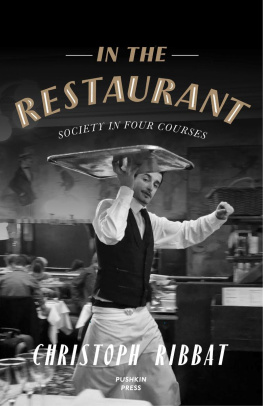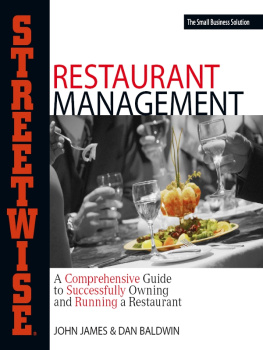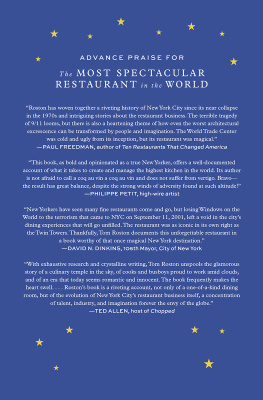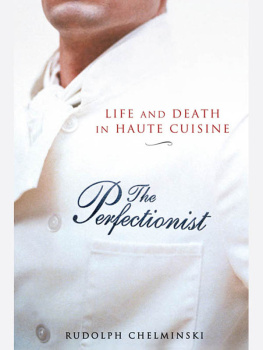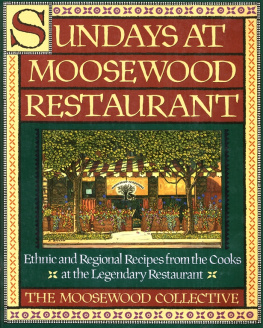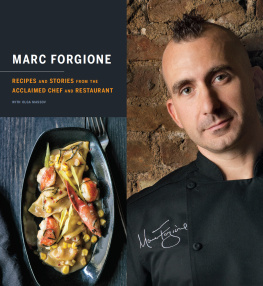F rances hurries through the crowds of Chicago. She is looking for a job as a waitress. The trams screech in her ears, a policemans whistle shrills, the L train thunders. She is thirty-seven, a teacher by training. She started off in a village school with just one classroom, near St Clair in Michigan, right out by the Canadian border. She has lived in the suburbs of Detroit, in the suburbs of Chicago, and then in Great Falls, Montana. That was when she married William and stopped teaching. Then the economy in Great Falls collapsed. They moved back to Chicago. And William became incurably ill. In her threadbare black dress, Frances battles her way through the crowd of people in dark, narrow Van Buren Street. She has seen a job posting in the Chicago Daily News. Now she stands in front of the restaurant. She looks in through the window at the bright, decked tables, at ladies and gentlemen eating at leisure, white-aproned girls holding plates in their hands. Frances hesitates. Should she go in or not? Her heart is beating so fast, she writes later, that she almost cant breathe. But she enters eventually, and asks the man behind the cigar counter whether they need a waitress. Yes, he says. They did. But they hired one just yesterday. I see, says Frances. She flees back on to the street, back into the hubbub of the year 1917.
*
The Chinese capital is famous for its restaurants. Fish and seafood are excellent here, as are beef, poultry and noodles. The choices are many and varied, because the restaurants arent just catering to long-established residents, but also to the refugees who now call this their home. Their traditions and dietary restrictions for example those of Muslim residents enrich the diversity of the local cuisine. The sweet soy soup at the market comes highly recommended. Also worthy of mention are Mother Songs fish soup and rice served with mutton, while in front of the Longevity and Compassion Palace, meat cooked in ashes is on offer. The boiled pork at Wei-the-Big-Knife at the Cat Bridge is outstanding, and the honey fritters from Zhou Number Five by the five-span pavilion are absolutely exquisite. This is all according to a gourmet. In the year 1275 he writes about the impressive gastronomic scene in Hangzhou, the capital during the Song dynasty.
*
The history of the European restaurant begins with the fact that people arent hungry. Or at least, they act as though they arent. In Paris in 1760, with all its malnourished inhabitants, it wouldnt be in keeping with the zeitgeist for the elite to stuff themselves to bursting point in some tavern or inn. Anyone with any sense of decorum has a delicate constitution. Unable to stomach much, they barely eat a thing, but still take their time about it. The upper-class clientele are enticed by the restaurant, this luxuriously furnished new style of inn. Large mirrors in which to admire oneself and others hang on the walls. The restorative bouillons which lend the new restaurants their name, derived from the Latin restaurans, steam from decorative porcelain bowls. Made from poultry, game or beef stock, these brews are said to replenish the strength of those who are too sensitive for other forms of nourishment.
It is not the bouillons which make the restaurant successful, however, but rather its focus on individuals and their desires. Customers here dont have to sit at a long, shared tavern table with all sorts of strangers. They get a table all to themselves. They can decide the hour at which they wish to be served. They make their choices from a menu.
*
Out in Van Buren Street, in front of the restaurant with the bright tables and smart waitresses, Frances, rejected would-be waitress, briefly feels relieved. But then she has to make her way onwards, to the next establishment that has placed an ad in the Daily News. She is just one of countless women in Chicago who are competing for jobs. She has often thought about these crowds of women, crashing into the heart of the city from the outskirts each morning like a tidal wave. Many are young, some already middle-aged, making themselves look And Frances wants to be one of them.
So she moves on. In the next restaurant, a woman is standing behind the cigar counter. She sends Frances on to a young man, who, in turn, refers her to a gentleman in the backroom, the manager, who is sorting aprons and jackets. She asks him whether he needs another waitress. He asks her whether she has worked as a waitress before. She lies and says yes. He asks her whether she is quick on her feet. She asks him whether it looks like shes not. And then another young man leads her down a narrow staircase into a damp, foul-smelling cellar. Here, ten young women are getting changed, putting on lipstick, sweeping rouge across their cheeks, powdering their noses, tossing make-up brushes back and forth and cursing with a crudity that Frances has never heard before in her life. No one pays any attention to her at first, but eventually one of the quieter girls helps her get into her uniform. Frances is now a waitress. A waitress with a secret.
*
On the surface, the early Parisian restaurant resembles the cafs in which bourgeois public life develops. People come together in the cafs. They debate. They argue. Everything is very different from church or the royal court, different from the elite salons, the academies or scholarly societies. Anyone
But the restaurant is different. You dont go there to debate with others, nor to read the newspaper. You go to unwind or to put your sensibility on show. Once seated at the table, you make a choice that has little bearing on the broader political situation: between poultry, game or beef bouillon. The blend of public and private life sought here leans more towards the private. The Parisian caf offers large rooms in which you can see everything and everyone. The restaurant, on the other hand, has niches and alcoves for customers to retreat into groups and couples alike. There are cabinets particuliers special rooms in which one can conduct private conversations or meet for assignations ranging from the romantic to the erotic.
*
This is what Frances Donovan isnt telling her colleagues: she wants to become a waitress for research purposes, not because she needs the money. With William being terminally ill, it has become clear to her that she will have to make her way through life alone in future. So she has decided to get another degree. She is studying English at the University of Chicago with a minor in sociology.
The Chicago School of Sociology is becoming world-renowned. In these early days, Frances is a part of it.
Frances Donovan is so impressed by these concepts that she herself becomes a sociologist. A freelance one, so to speak. Without any contract, position or research funds, she sets out. And in the wilds of the new Chicago, there is no figure more interesting to her than that of the waitress. In 1917, Frances becomes one of them. One year later, in 1918, William will die of his incurable illness. And two years later still, in 1920, a Boston press will publish The Woman Who Waits. It is the first academic study of the modern waitress, written by Frances Donovan.
*
Before long, Parisian restaurants of the late eighteenth century are filled with the scent of more than just bouillon. Theres chicken and macaroni, compotes and crmes, eggs and confitures.
The era of the restaurant critic is dawning. Alexandre Balthazar Laurent Grimod de La Reynire publishes the Almanac of the Gourmand, releasing new volumes regularly throughout the first decade of the nineteenth century. Grimod is tremendously successful. Writers have turned their attention to food before, of course. But it is new for the emphasis to be exclusively on the culinary and on a world peopled only by consumers and chefs.

